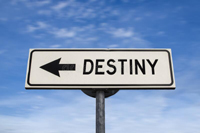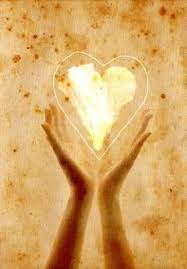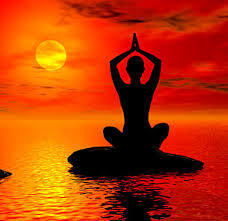Inner approach to health
The signpost to our destiny
Abstract
This article is about reversing our consciousness to the inside. It is the first step we attempt to make in yoga. When the soul is ready it is always presented with a choice, which means to live inwardly and reject the trappings of the outer life. Initially, this reversal seems unnatural to our nature. Consequently it can be a long and painful process but it is the only way to acquire authentic control of our complex being and our life.
Many people reach a specific juncture where they cannot stay any longer with the surface life. The realisation often comes in the form of a breakdown. For some, the initiation will come through suffering and pain. It is surprising how many of us have to go through calamitous experiences before embarking on a truer life. Many of us need this ‘wake-up call’. Without it, there would only be an aimless drift. Very often a catastrophe will point to a calling. Sooner or later, there arises an imperative need to make this shift. On many occasions, illness may precipitate this change. At least that was my experience. A crisis of the body was the trigger which ultimately drew me to the Divine. One also encounters what can be termed an existential crisis. The dilemma has implications for more than our well-being; it shakes the whole foundation of our existence. The aspiration to live our Truth is something innate in all of us but it is buried by the influences that we have had to bear in life. So we have to learn to dig.
Our Truth is not found on the outside; it can be embraced only by going inside. Due to conditioning, man is tied to the surface but something dramatic often impels him to break free of these bonds. All our outer props may collapse to the ground. We do not know which way to turn; all the old solutions disappear. We may feel abandoned and isolated. We feel surrounded by darkness and find no substance and meaning in our present existence. We may be facing unbearable loss and grief. We may feel trapped and caged in by stifling conditions surrounding us. But they all only present a mirror into our empty inner world, “a kind of dull, lifeless greyness, a chaotic mixture of disorganised things, with the faintest light… (1)”.
In everyone, what impels is a state of deep-seated dissatisfaction. However it is not necessary for everyone to traverse through a catastrophe. Not everyone has to endure a dysfunctional upbringing, there are many raised in a healthy and nurtured way, who have been inspired with some thirst for the Truth at an early age, so the way forward is more seamless and clear. But still there is still this dissatisfaction, a longing to discover greater riches inside.
If nothing is done to break free of the stagnancy of the outer life, one faces the prospect of pursuing a futile treadmill for countless incarnations. For those souls who do not relish challenges, it offers a more comfortable life with fixed grooves. It can become a habitual pattern for many lives. So many people are ignorant of their own malaise. They do not really know how miserable they are. They live through an auto-pilot and have forgotten the true meaning of their existence:
“Almost totally, everybody lives on the surface, all the time, all the time on the surface. And for them it’s even the only thing which exists — the surface. And when something compels them to draw back from the surface, some people feel that they are falling into a hole. There are people who, if they are drawn back from the surface, suddenly they feel they are crumbling into an abyss, so unconscious they are! They are conscious only of a small thin crust which is all that they know of themselves and things and the world, and it is so thin a crust (2)!”
So the turn inside is probably the most significant movement we make in life. There is no doubt that it also has profound implications for our health and well-being. First of all, we need to create an environment conducive to this process. To a certain extent, this may even initially require ring-fencing ourselves off from the outside world. The sapling’s tender shoots are so tempting for society’s cattle to gorge upon! Our surroundings may present immense obstacles to this realignment. In my own experience, I felt that an entire relocation to India was required! At the very least though, we need to create our own sacred space. This is just the beginning.
We don’t aim to ultimately disengage from the spume of everyday life — that is not really possible — but we try to establish a poise which is distinct and apart from the influences of the surface life. We learn to do this in every facet of our existence. In the end, we draw on a greater power in our interactions with the outside world and we base everything on this poise inside. Up to that point, we are tossed around entirely by circumstance and open to every conceivable exterior force. In truth, we start to live. Before this point, one is immersed in a world of dream and illusion, where only the phenomenal seems true.
It is only by living from inside that one can access true mastery over our complex individuality. This control gives us the prospect of vibrant health. It is the psychic being alone, our evolving soul accompanying us through all our lifetimes, which offers this reality and this entity can only be found and realised by looking inside. The psychic being exists in a wholly different dimension. The shift can only be realised by cementing our consciousness inside. It is the first step we take in all yogas. If we aspire for a truer life we need to be conscious and to become conscious we have to turn inside, “for this one must work a little within oneself. One must withdraw from the surface (3). ” The psychic being is our true identity and we simply have to know who we truly are. Self-knowledge is the key.
Consciousness and well-being
Our well-being is always determined by the state of our consciousness and the quality of our consciousness is the perfect barometer of our equilibrium inside. As soon as we switch command of this consciousness to the inside, we start to assume authentic control over it and the state of our health. As the Mother says, it is the ‘inside which governs the outside’. Mastery of our psychology is only accessible from this poise as a balanced psychology is the essential backdrop to all physical health. However, it is a great challenge to achieve all this. Every part of our nature will resist this reversal. The ego certainly doesn’t want it; it loves to pull the strings from the surface. But how can we begin the process when virtually all our nature is dominated by ego?
A calling comes and we respond! A dormant aspiration awakens and inspires the adventurer in us to set our course on living from our true centre. It is a time for stupendous personal effort. For a long time, we have no option but to work through our ego nature. This nature needs to be inspired and refined; it requires skilful handling. There is an aspect to it which resonates more closely to the Inner Presence; we have to work through it until we are able to base ourselves securely in the soul.
Time and again, we might feel the gravitational pull of the surface life. We receive brief glints of Light and automatically a downward tug occurs. But these brief flashes of Light inspire us and keep us going. They become milestones in our sādhanā. We even begin to recognise these ‘pulls’ as an automatic reaction from our separative nature. We learn to pre-empt this resistance. By working inside more, we learn to read the signals. We start to acquire true knowledge and knowledge becomes the priceless armour in our inner healing.
Practice
To sustain the inner poise is our practice, so we need to find a space where we can always dwell and offer. We have to learn to be always present. The definitive poise in Integral Yoga is surrender. We have to surrender what we are to the Divine and the process is to offer. It is our inner aspiration which fuels this process. We cannot truly offer from our instrumental nature, from the outside. It is our Truth alone that can offer so it is imperative that we find it and then live through it. We offer the good and the bad. We should do more than offer in hindsight; we should offer as soon as every inner movement rises to the surface. This motion of surrender and self-giving is the most important process we undertake in Integral Yoga.
“Not only is the positive movement of self-giving necessary but also the negative movement of rejection of everything in you that opposes this giving (4).”
This surface life resonates deeply what is surface within our own being, namely the ego. The more that one identifies with the outer life the more indistinct and narrow our outer consciousness becomes and it will leave no bridge for the psychic being to step forward.
Actually, the Mother said that most people, “do not have their psychic being within them.” Virtually everyone lives on the surface. The psychic being is there at the centre of their being, but “their outer consciousness is so small, so limited, so obscure that it is not able to keep a contact, not only conscious but intimate, with the psychic being (5).” In those cases, it has scarcely emerged at all.
Before our consciousness evolves, it is our awareness which has to be turned inside. This is the first step in our growth. We start to acquire something of a Witness poise. This witness takes its station above the exterior play. It observes the action and the actors like a disinterested spectator and something more durable and stable starts to settle in the being. This is a necessary stage in our growth but as we intend to grow in an integral way, we must not stop there. We must always seek to exceed ourselves and become vaster than our experiences.
Ultimately however, what determines our growth is the condition of our consciousness. Up to this point one might be living on a borderline between consciousness and awareness. There is something very detached and settled. We identify with that but there is no mastery. There is no dynamic capacity to change. What will bring about this seismic change is the intervention of the psychic being. We start to become aware of this concealed Presence. Our awareness starts to identify with the soul and gradually our consciousness steps forward and solidifies. It is the psychic being which moulds, refines and shapes our true consciousness. When the consciousness searches for its true nature, the consciousness becomes dynamic and expands and as we nurture and tend it, the psychic being moves forward. Both nurture each other. The work revolves in a beautiful and endless circle. Everything is a consequence of the aspiration behind this movement.
The consciousness doesn’t just witness it identifies. It is not just aware; it acts.This power of identity comes from the psychic influence. This is why the Mother equates consciousness as the “faculty of being aware of anything whatsoever through identification with it. But the divine consciousness is not only aware but knows and effects (6).” The sense of identity that we feel with this Truth makes the consciousness so much more alive; it invests it with such an irresistible Force.
Bringing the inner life to everyday life
The inner poise should be maintained at all times but there are many instances where this state easily eludes our reach. I shall take two examples. These are settings which must be conquered. We have to learn to live inwardly in the mayhem of the world and first we shall look at work. True work represents an inner communion with the Divine, which is the foundation to all karmayoga, but it is the very activity which initially so resists the inward turn. This is probably why karmayoga becomes our quickest route to realisation. The difficulty hides so many riches. Initially in sādhanā we find every action we undertake has a way of throwing our consciousness back onto the surface. Normally we identify only with the physical effort, not what is behind it. Even with mental work, our consciousness gets habitually pulled through the narrow passageways of the brain. In work too, we interact and every interaction has a way of pulling us onto the surface. These are the kinds of challenges that we face in this yoga. But the difficulties we confront are a portent to the vastness that we acquire if we actually succeed.
In karmayoga, there are no boundaries. Every action we make is work. We need to be in authentic control of all our work and authentic control only comes when the results of our work are left to the Divine. Then the task ceases to be our possession. Something vaster than our ego can then take charge. Everything becomes an offering to the Supreme. It is a never-ending process. We offer from inside and identify more and more with the Supreme inside. It is this identity which keeps our consciousness rooted inside: to the Truth.
Family life
One other challenge we might face comes from family-life. The vast majority of society is part of these groupings. Only a few opt for the seclusion of ashram life. Here, at the Sri Aurobindo Ashram, a way has been found to integrate families within the larger collective. The integral path offers a unique synthesis of the inner and outer life. The exterior façade is not shunned but offered for transformation; society is not rejected but absorbed within its transmuting embrace.
Nevertheless, the consecration demanded in Integral Yoga demands that the attachments of family life need to be completely excised. In the typical family of today, attachment is a fact of life and it is attachment which suffocates all inner growth. It is attachment which feeds the ego and brings everything so much to the surface. There can be no love in attachment, only a very pallid and unsatisfactory substitute.
This dichotomy presents a massive challenge for the aspiring soul. We may feel really stuck in the quagmire of the surface life. Some may not be able to bear it and will look for a suitable escape. The path of isolation and renunciation may beckon. In the bosom of the family, we repeatedly find our patterns and formations mirrored in those around us. On the integral path, if one is sincere, one becomes conscious of more and more knots and stains that need to be offered to the Light. These attachments should be offered too. The interchange of the family life needs to be enhanced by a state of conscious and loving acceptance. This love needs to be drawn inward and rarefied beyond the clutches of the ego. All this can be done. The forum provides a tremendous opportunity for growth but there are not many capable of advancing in such an unyielding atmosphere. There are so many distractions and we have to constantly re-orient ourselves inside. It requires a herculean effort and there are no half-measures. Ultimately, we bring harmony all around us. If one backs down from this, one heads for breakdown; one will compromise and inexorably sink.
The signpost
Each one of us has a choice. We walk life’s path and eventually come across a signpost, a signpost which determines the greatest decision that we ever have to make. The choice will dictate the entire orientation of our existence. One sign is pointing inwards and the other points outwards. If our soul is sufficiently awake there can only be one decision: to follow the inner path. One may delay and procrastinate when one is confronted with this choice, but sooner or later, one must follow one’s Truth. The fact that the signpost has appeared at all implies that we are now confronted by a mandate of the soul. Otherwise it would not be there. It shows that our soul has ripened and we are ready. We are ready. The decision we have to make is really a no-brainer: it is spiritual suicide to reject this command. Whatever life throws at us, we must, “Cling to Truth (7)” and that means to live inside.
References
1. The Mother. The Collected Works of the Mother, Volume 7. 2nd ed. Pondicherry: Sri Aurobindo Ashram Trust; 2003, p. 279.
2. Ibid., p. 278.
3. Ibid.
4. The Mother. Collected Works, Volume 4; 2003, p. 358.
5. Ibid., p. 139.
6. The Mother. Collected Works, Volume 3; 2003, p. 167.
7. The Mother. Collected Works, Volume 14; 2004, p. 192.
James Anderson is a member of SAIIIHR and coordinating editor of NAMAH.
Share with us (Comments,contributions,opinions)
When reproducing this feature, please credit NAMAH,and give the byline. Please send us cuttings.






